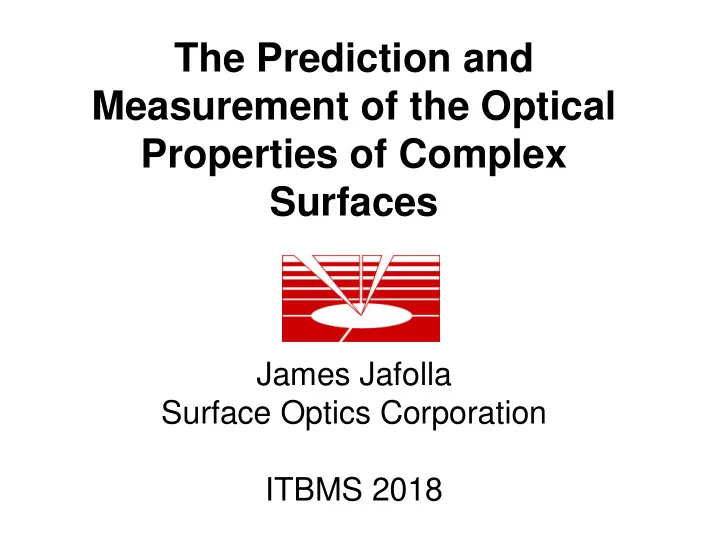

The Prediction and Measurement of the Optical Properties of Complex Surfaces James Jafolla Surface Optics Corporation ITBMS 2018
Outline • Introduction • BRDF Definition • BRDF Models – Micro-Optic Surface Model – Sandford-Robertson Model • BRDF Measurements • BRDF Model-Measurement Comparison • Implications for Signature Analysis
Introduction • Development of advanced CGI rendering tools requires better understanding of light scattering from surfaces • Virtual prototyping for signature analysis and system design requires accurate radiometric analysis • Most current computer analysis relies on simplified assumptions of surface optical properties • Phenomenological ray tracing analysis provides accurate prediction of optical properties
Bidirectional Reflectance Distribution Function (BRDF) BRDF: ( ) , , i r ( ) ( ) dN , = r r , , cos d ( ) i r i i N i i ( ) DHR: D i ( ) N r = ( ) , , cos sin d d r r r r i N i i ( ) = D i i (These apply to isotropic surfaces; also, r = Incident Zenith Angle − here.) r i = Reflected Zenith Angle = = Reflected Azimuth Angle For Lambertian Diffuse Surface D
Modeling the BRDF of Complex Surfaces • Many surfaces exhibit a complex surface features • Large scale features exhibit multiple reflections and blocking and shadowing • Small scale features based on homogeneous material optical properties, surface roughness • Non-homogeneous mixtures of materials
Micro-Optic BRDF Calculation • Approach defines Micro-Optic facet model of surface • Ray-tracing includes reflections and blocking between facets • Sandford-Robertson model for facet optical properties
Geometrical Surface Structures • Structured Surfaces for Thermal Design • Ref. Seigel R. and Howell J., Thermal Radiation Heat Transfer , McGraw-Hill, 817pp, 1972 • Arbitrary Structure Surfaces Represented as Faceted Wire-Frame Models • Arbitrary Surface Coatings on Facets
Pyramid Surface Definition Machined Surface
SOC-210 Bi-Directional Reflectometer Unpolarized BRDF Bidirectional Transmittance Distribution Function (BTDF) Automated Full Hemispherical Mapping: i = 0 through +85 r = 0 through +85 i = 0 - 350 r = 0 - 345 Spectral Coverage: Sources 0.35 – 1.6 m quartz halogen 1.5 – 16.0 m SiC glower source Assorted bandpass filters Detectors 0.35 -1.0 m Silicon detector 1.0 – 1.6 m InGaAs detector 2.0 – 14 m dual InSb/MCT
BRDF Measurements
Sandford-Robertson Model • Based on the separation of the spectral and directional dependence of the total BRDF l = l ( , ; , ; ) f ( , ; , ) ( ) i i r r r i i r r = + f ( , ; , ) f ( , ; , ) f ( , ; , ) r i i r r S i i r r D i i r r • Fits four parameters to the BRDF D ( l ) = Diffuse Spectral Reflectance e ( l ) = Spectral Emissivity b = Grazing Angle Reflectivity e = Width of Specular Lobe
Sandford-Robertson Model Fit to Measurements
Analytical SR BRDF Models Good Specular Mid Specular Bad Specular
Model/Measurement Comparison Theta Incident 40 deg Prediction Measurement
Study of Grooved Surface • 30 degree right triangle surface wedge • Movie generated of BRDF for high resolution steps in Phi Incident for various Theta Incident angles • Good specular surface BRDF
Incident Angle 35 Degrees
Incident Angle 55 Degrees
Incident Angle 65 Degrees
Implications For Signature Analysis • Regular (structured) surface features produce multiple BRDF lobes • Lobes move predictably as a function of all four incident and scattered angles • Inclusion in signature models using high resolution data tables and interpolation possible • Parameterized models have been attempted
Hilgers BRDF Model • Developed to Model Materials with Multi-Lobe BRDF Features • Gaussian Lobe Shape • Closed Form Solution - No Iterative Fitting • Lobes “ Tracked ” to Define Significant Features – i.e., Lobe Bifurcation or Coalescence • Rapid Generation of BRDF for Rendering Applications ˆ ˆ − = ( k , k ) Ae i r = − + − − + − 2 2 a ( ) 2 b ( )( ) c ( ) r r r r r r r r A determined from BRDF peak , r determined from first moment of BRDF r a , b , c determined from second moment of BRDF
Multi-Lobe BRDF Comparison Q i =10 i =0 Gaussian Model MicroOptic BRDF Q i =50 i =40
Full BRDF Provides Realistic Rendering Courtesy: George Borshukov, ESC Inc.
Computer rendered character from a “famous” movie. photo rendered Courtesy: George Borshukov, ESC Inc.
Conclusions • Simple parameterized BRDF models not well suited for complex surface treatments • Micro-Optic BRDF model provides ability to represent complex, non-homogeneous surfaces – Geometric facet model of surface – Multiple bounce ray-tracing calculation – BRDF of homogeneous facets computed from Sandford- Robertson model • Good agreement of BRDF calculations to measurements for a manufactured structured surface • More work needed for including these effects into signature calculations
Recommend
More recommend